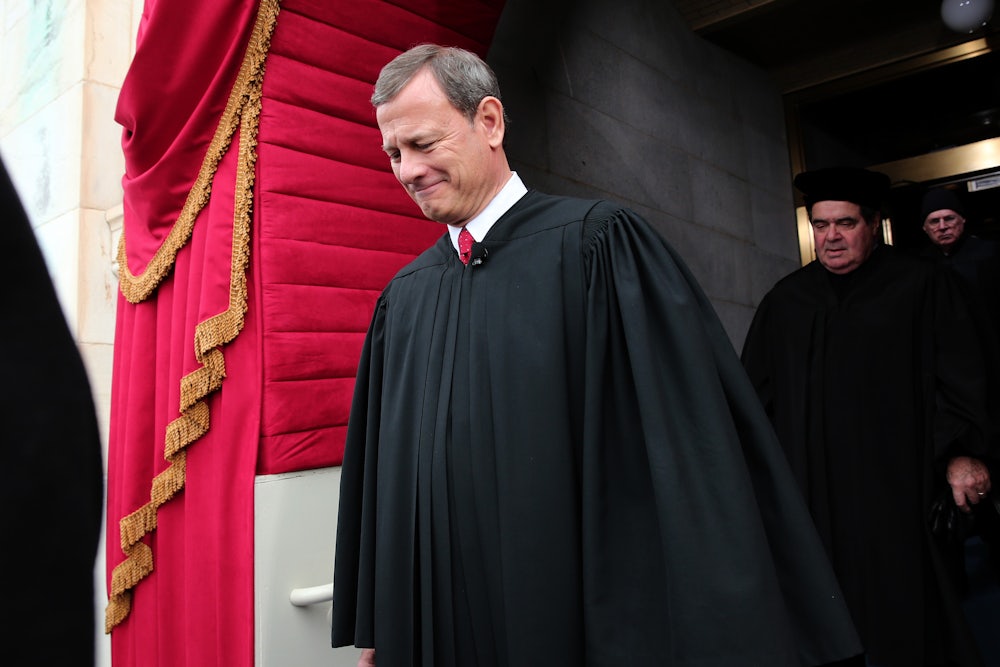Senate Republicans, in suggesting they might not consider any eventual Obama nominee to replace the late Supreme Court Justice Antonin Scalia, have created a true nightmare scenario for the Court in general—and Chief Justice John Roberts in particular. As I have written before, Roberts has repeatedly decried perceptions that polarization in the political branches will “spill over” and undermine the court’s stature. As recently as February 4, he has insisted, “We don’t work as Republicans or Democrats,” and that “people don’t have a really good understanding of what the Court does.” But now Republicans have drawn his Court into the middle of the biggest political fight of the decade.
Roberts has criticized Senate obstructionism before. In his 2010 annual report on the judiciary, he wrote, “Each political party has found it easy to turn on a dime from decrying to defending the blocking of judicial nominations, depending on their changing political fortunes. This has created acute difficulties for some judicial districts.” If Roberts is serious about such laments, there is much he can do to mitigate this crisis.
What should his strategy be? To simply do his job. Or rather, his two jobs: like his colleagues, to be a conscientious jurist by respecting precedent, anchoring decisions in the text and history of the Constitution and laws, and consistently applying principles and reasoning he himself has endorsed; and, as chief justice, summon the judicial statecraft and discipline necessary to protect the federal judiciary’s role in the constitutional scheme and the values that drove the framers to design that role.
Pundits are predicting an unbroken skein of 4-4 partisan stand-offs in the numerous politically charged cases on the Court’s 2015-16 docket. But if Roberts stays true to his own precedents and principles—even if doing so yields a few rulings that will spark Republican outrage—the Court will defy those cynical forecasts. That scenario will be the most persuasive, if temporary and not by itself conclusive, antidote to perceptions that political polarization has crossed First Street N.E., from the Capitol Building to the Court.
Consider three pending cases widely thought likely to generate party-line splits among the Court’s eight members:
Evenwel v. Abbott: Conservative legal activist Edward Blum, long out to end affirmative action and dilute minority voting power, claims that the Equal Protection Clause of the Fourteenth Amendment doesn’t refer to all people who live in a state, but only the eligible voters within that jurisdiction. If successful, this claim would drastically shrink the state legislative representation of metropolitan residents, minorities, younger persons, and others. The lower court dismissed the case, noting that its proponents rely upon “a theory never before accepted by the Supreme Court or any circuit court.” When the Fourteenth Amendment was debated and adopted, its congressional framers repeatedly argued that “the whole population is represented; that although all do not vote, yet all are heard. That is the idea of the Constitution.” It shouldn’t be a heavy lift for Roberts to use precedent, originalism, and practicality to reject this partisan power-grab.
Friedrichs v. California Teachers Association: Conservative business and political activists are looking to overturn a 39-year-old unanimous decision by a Court composed of seven Republican appointees which ruled that the “National Labor Relations Act leaves regulation of the labor relations of state and local governments to the States,” and that “important government interests” required deference to state judgments as to how to balance those interests with individual employees’ opposition to paying union dues. Lawyers for the U.S. Chamber of Commerce seek to shelve that precedent with a claim that the First Amendment in effect requires public employee unions to work for all employees in a bargaining unit, whether they pay dues to support that work or not. A 4-4 split would further raw partisan power interests while flouting precedent, fidelity to originalist scruple, and a long-established guarantee of states’ authority to manage their own workplaces.
United States v. Texas: The state is challenging the legality of the U.S. Department of Homeland Security’s decision to defer removal action, for three years on a case-by-case basis, regarding undocumented parents of U.S. citizens and legal residents. If Roberts maintains his longstanding support for strict criteria governing the “standing” to sue—especially suits by states and other political entities—he will dismiss this challenge on standing grounds. The Fifth Circuit’s 2-1 decision upholding Governor Greg Abbott’s suit constituted, as the dissenting judge wrote, “a breathtaking expansion of state standing [that] would inject the courts into far more ... review of the political branches.” Justice Anthony Kennedy could be particularly well-positioned to join Roberts in rejecting Abbott’s challenge—on the merits as well as standing. Kennedy concurred in rejecting the Obamacare challenge in King v. Burwell, and, in 2012, authored a strong affirmation of federal primacy vis-à-vis the states on immigration policy matters, in which Roberts joined.
